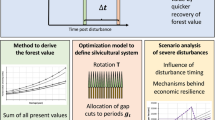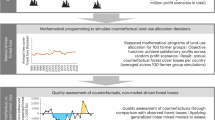Abstract
Given the importance of anthropogenic determinants in forest ecosystems within Europe, the objective of this paper is to link the evidence arising from biological models to socio-economic determinants, where the expected returns of forest investments represent the main driver. A micro-economic area allocation module is therefore coupled with an inventory-based forest dynamics module and a partial-equilibrium market module in a national-level forest sector model for France (FFSM++). Running long-term scenarios (until 2100), we show the implication of an active management policy on forest composition: when the most profitable option drives forest investments, coniferous forests are generally preferred over broadleaved ones. This result is, however, reappraised when the risk aversion of forest owners is explicitly considered in the model, given the higher risk associated with the former. We further show the strong stability of forest ecosystems that, due to the very long cycles, undergoes very small variations in volume stocks, even in scenarios where the initial forest regeneration is strongly influenced.





Similar content being viewed by others
Notes
The structure of the forest trade balance in France is strongly oriented toward net exports of primary products (215 Million USD, with exports 2.4 times the imports) and net import of transformed products (1912 Million USD, with imports 2.0 times the exports) [16].
This scenario is actually available in the Supplementary Material as areaIncrease.
Those forest/agriculture interactions in a context of climate change will be investigated in a future study within the framework of the ORACLE project. This study thus represents the first, yet necessary step in a broader analysis.
Given the very high fragmentation of the forest property in France (the average forest size by management unit is 4.44 ha [17]), we consider forest managers as price takers and myopic in terms of equilibrium effects: they know the current prices and the forecasted prices driven by exogenous factors like climate change, and they form heterogeneous expectations based on them, but they do not know the other forest managers’ expectations and hence they do not know how the sum of the expectations may influence the actual price in the future. They do, however, update their expectations using the newly available information as the model progress. In this regard, economic agents (here the forest managers) have what [30] would call “adaptative expectations”.
A proper comparison of gross margins would necessarily include information about the cost aspects in the expected returns, whereas the area allocation module currently only works with information about the revenue aspects, assuming similar costs between forest types. Using the supply function as an indicator of marginal costs may be a way to deal with this issue.
The full set of results, including regional ones, is available in the digital archive that accompanies this paper.
Results for forest dynamics and markets are available in the “Complete model output” folder in the files “/output_{scenario_name}/results/forestData.csv” and “data/output_{scenario_name}/results/productData.csv”, respectively, and as pre-formatted tables and charts in file “results_complete.pdf”.
Input data is located in the corresponding folder in the “ffsmInput.ods” spreadsheet and in the gis maps under “gis”.
The complete source code of the model is available under a permissive open-source license (a modified GPL licence) under “Model source code”.
The active regeneration rate a R R is set to 0.5 here for all scenarios.
Since Eq. 10 is linear on r A, the average expected returns do not change because of a direct increase in its variance. However, Eq. 4 is not linear, and compared with a homogeneous risk aversion and a preference for coniferous forests, increasing variance leads to some switches to broadleaved forests that, in turn, affect coniferous volumes (−), prices(+) and, as a result, expected returns (+). However, we found this effect to be very marginal.
One of the reasons for this dualism in forest modelling is that the tools used are themselves different. Ecologists often use a general programming approach to build their models (C++, Matlab, Python, etc.), whereas economists often use programmes specialized in solving equilibrium problems like GAMS [6]. Our approach has been to instead use a generic programming language (C++) that gives us the flexibility required to build a complete forest dynamics and area allocation module with specialized software libraries, namely IPOPT [46], ADOL-C. [45], and ColPack [18], used to solve the Samuelson equilibrium and therefore build the market module.
References
Allen, C.D., Macalady, A.K., Chenchouni, H., Bachelet, D., McDowell, N., Vennetier, M., Kitzberger, T., Rigling, A., Breshears, D.D., Hogg, E.T., Gonzalez, P., Fensham, R., Zhang, Z., Castro, J., Demidova, N., Lim, J.-H., Allard, G., Running, S.W., Semerci, A., & Cobb, N. (2010). A global overview of drought and heat-induced tree mortality reveals emerging climate change risks for forests. Forest Ecology and Management, 259(4), 660–684. doi:10.1016/j.foreco.2009.09.001.
Armington, P.S. (1969). A theory of demand for products distinguished by place of production. Staff Papers, 16(1). International Monetary Fund.
Brunette, M., Dragicevic, A., Lenglet, J., Niedzwiedz, A., Badeau, V., & Dupouey, J.-L. (2014). Portfolio management of mixed-species forests. Technical report, Laboratoire d’Economie Forestiere, AgroParisTech-INRA.
Buongiorno, J., Zhu, S., Raunikar, R., & Prestemon, J.P. (2012). Outlook to 2060 for World Forests and Forest Indusries. Available from: http://www.treesearch.fs.fed.us/pubs/40454.
Buongiorno, J., Zhu, S., Zhang, D., Turner, J., & Tomberlin, D. (2003). The global forest products model: Structure, estimation, and applications. San Diego: Academic Press.
Bussieck, M.R., & Meeraus, A. (2004). General algebraic modeling system (gams). In Kallrath, J. (Ed.) Modeling Languages in Mathematical Optimization (pp. 137–157). Norwell, MA: Kluwer Academic Publishers.
Cassels, J.M. (1933). The nature of statistical supply curves. Journal of Farm Economics, 2, 378–387. Available from: http://www.jstor.org/stable/1231011.
Caurla, S., Delacote, P., Lecocq, F., & Barkaoui, A. (2013a). Combining an inter-sectoral carbon tax with sectoral mitigation policies: Impacts on the French forest sector. Journal of Forest Economics, 19(4), 450–461.
Caurla, S., Lecocq, F., Delacote, P., & Barkaoui, A. (2010). The french forest sector model version 1.0. presentation and theoretical foundations. Cahier du LEF 2010-03, Laboratoire d’Economie Forestiere, Nancy.
Caurla, S., Lecocq, F., Delacote, P., & Barkaoui, A. (2013b). Stimulating fuelwood consumption through public policies: An assessment of economic and resource impacts based on the french forest sector model. Energy Policy, 63, 338–347.
Colin, A. (2010). Calibration du module biologique du ffsm. Technical report, Inventaire Forestier National.
CRPF-Bourgogne (2012). Renouveler un peuplement de chêne par plantation ou régénération naturelle. Available from: http://www.foret-de-bourgogne.org/files/pdm_chene/renouveler%20un%20peuplement%20de%20chene.pdf.
Delacote, P., & Lecocq, F. (2011). Fuelwood, timber and climate: Insights from forest sector modeling- an introduction. Journal of Forest Economics, 17(2), 107–109.
Delacote, P., Kallio, A.M.I., & Harou, P. (2013). Editorial. Journal of Forest Economics, 19(4), 347–349. doi:10.1016/j.jfe.2013.11.001. Forests, wood and climate: New results in forest sector modeling.
FAO (2010). Global forest resources assessment 2010. Available from: http://www.fao.org/forestry/fra/fra2010/.
FAO (2013). Foresstat - forest products production, import and export statistics from 1961 onwards.
FCBA (2014). Mémento 2014. Available from: http://fcba.fr/sites/default/files/files/memento2014.pdf.
Gebremedhin, A., Nguyen, D., Patwary, M., & Pothen, A. (2013). Colpack: Software for graph coloring and related problems in scientific computing. ACM Transactions on Mathematical Software.
Gollier, C. (2001). The economics of risk and time: MIT press.
Kallio, A.M.I., Moiseyev, A., & Solberg, B. (2004). The Global Forest Sector Model EFI-GTM - The Model Structure. European Forest Institute. EFI Internal Report 15.
Kallio, A.M.I., Moiseyev, A., & Solberg, B. (2006). Economic impacts of increased forest conservation in Europe: a forest sector model analysis. Environmental Science & Policy, 9(5), 457–465. doi:10.1016/j.envsci.2006.03.002.
Knoke, T., Ammer, C., Stimm, B., & Mosandl, R. (2008). Admixing broadleaved to coniferous tree species: a review on yield, ecological stability and economics. European Journal of Forest Research, 127(2), 89–101. doi:10.1007/s10342-007-0186-2.
Lecocq, F., Caurla, S., Delacote, P., Barkaoui, A., & Sauquet, A. (2011). Paying for forest carbon or stimulating fuelwood demand? insights from the French forest sector model. Journal of Forest Economics, 17(2), 157–168.
Lien, G., Størdal, S., Hardaker, J., & Asheim, L. (2007). Risk aversion and optimal forest replanting: a stochastic efficiency study. European Journal of Operational Research, 181 (3), 1584–1592. doi:10.1016/j.ejor.2005.11.055.
Lindner, M., Maroschek, M., Netherer, S., Kremer, A., Barbati, A., Garcia-Gonzalo, J., Seidl, R., Delzon, S., Corona, P., Kolström, M., Lexer, M.J., & Marchetti, M. (2010). Climate change impacts, adaptive capacity, and vulnerability of European forest ecosystems. Forest Ecology and Management, 259(4), 698–709. doi:10.1016/j.foreco.2009.09.023.
Lobianco, A., Delacote, P., Caurla, S., & Barkaoui, A. (2015a). The importance of introducing spatial heterogeneity in bio-economic forest models: insights gleaned from ffsm++. Ecological Modelling, 309-310, 82–92. doi:10.1016/j.ecolmodel.2015.04..
Lobianco, A., Dragicevic, A., & Leblois, A. (2015b). Forest planning and productivity-risk trade-off through the markowitz mean-variance model. Cahier du LEF 7, Laboratoire d’Economie Forestiere, Nancy.
Loustau, D. (2004). Rapport final du projet CARBOFOR. Available from: http://www.gip-ecofor.org/doc/drupal/gicc/7-01LousteauCraboforRF.pdf.
Markowitz, H. (1952). Portfolio selection. The Journal of Finance, 7(1), 77–91. Available from: http://www.jstor.org/stable/2975974.
Muth, J.F. (1961). Rational expectations and the theory of price movements. Econometrica, 29(3), 315–335. doi:10.2307/1909635.
Nabuurs, G.-J., Pussinen, A., Karjalainen, T., Erhard, M., & Kramer, K. (2002). Stemwood volume increment changes in European forests due to climate change—a simulation study with the efiscen model. Global Change Biology, 8(4), 304–316. doi:10.1046/j.1354-1013.2001.00470.x.
Neuner, S., Beinhofer, B., & Knoke, T. (2013). The optimal tree species composition for a private forest enterprise–applying the theory of portfolio selection. Scandinavian Journal of Forest Research, 28(1), 38–48. doi:10.1080/02827581.2012.683038.
ONF (2013). Itinéraires techniques de travaux sylvicoles (i.t.t.s.). plateau landais. Available from: http://www.onf.fr/outils/medias/20131010-142455-152919/++files++/1.
Petucco, C., Stenger, A., & Abildrup, J. (2014). Influences of nonindustrial private forest landowners’ management priorities on the timber harvest decision, Paper accepted at the Scandinavian Society of Forest Economics conference, Uppsala - May 2014.
Roessiger, J., Griess, V. C., & Knoke, T. (2011). May risk aversion lead to near-natural forestry? a simulation study. Forestry, 84(5), 527–537. doi:10.1093/forestry/cpr017.
Samuelson, P. (1952). Spatial price equilibrium and linear programming. American Economic Review, 42(3), 283–303.
Sauquet, A., Caurla, S., Lecocq, F., Delacote, P., Barkaoui, A., & Garcia, S. (2011). Estimating armington elasticities for sawnwood and application to the french forest sector model. Resource and Energy Economics.
Schelhaas, M., Eggers, J., Lindner, M., Nabuurs, G., Pussinen, A., Päivinen, R., Schuck, A., Verkerk, P., van der Werf, D., & Zudin, S. (2007). Model documentation for the european forest information scenario model (efiscen 3.1.3), EFI Technical Report 26, EFI. Available from: http://library.wur.nl/way/bestanden/clc/1857562.pdf.
Sjølie, H., Latta, G., Gobakken, T., & Solberg, B. (2011). NorFor - a forest sector model of Norway. Model overview and structure. INA fagrapport 18.
Thomson, T.A. (1991). Efficient combinations of timber and financial market investments in single-period and multiperiod portfolios. Forest Science, 37(2), 461–480. Available from: http://www.ingentaconnect.com/content/saf/fs/1991/00000037/00000002/art00005.
UNECE/FAO (2011). European Forest Sector Outlook Study II, UN. Available from: http://www.unece.org/efsos2.html.
Usher, M.B. (1969). A matrix model for forest management. Biometrics, 25(2), 309–315. Available from: http://www.jstor.org/stable/2528791.
Uusivuori, J. (2002). Nonconstant risk attitudes and timber harvesting. Forest Science, 48(3), 459–470. Available from: http://www.ingentaconnect.com/content/saf/fs/2002/00000048/00000003/art00001.
Van Brusselen, J., Moseyev, A., Verkerk, H., & Lindner, M. (2009). Item 4.b. outlook-related work at efi. In ToS EFSOS inaugural, 4-5 February, 2009, UN-ECE/FAO, Geneva.
Walther, A., & Griewank, A. (2012). Getting started with adol-c. In Schenk, U.N. und O. (Ed.) Combinatorial Scientific Computing (pp. 181–202): Chapman-Hall CRC Computational Science.
Wächter, A., & Biegler, L.T. (2006). On the implementation of a primal-dual interior point filter line search algorithm for large-scale nonlinear programming. Mathematical Programming, 106(1), 25–57.
Acknowledgments
This work was supported by the French National Research Agency through the ARBRE Laboratory of Excellence, part of the “Investissements d’Avenir” Programme (ANR 11 – LABX-0002-01) and the ORACLE project (“Opportunities and Risks of Agrosystems & forests in response to CLimate, socio-economic and policy changEs in France (and Europe)” - ANR-10-CEPL-011).
The funders had no role in study design, data collection and analysis, decision to publish, or preparation of the manuscript.
Author information
Authors and Affiliations
Corresponding author
Electronic supplementary material
Appendix A: Model notation
Appendix A: Model notation
Rights and permissions
About this article
Cite this article
Lobianco, A., Delacote, P., Caurla, S. et al. Accounting for Active Management and Risk Attitude in Forest Sector Models. Environ Model Assess 21, 391–405 (2016). https://doi.org/10.1007/s10666-015-9483-1
Received:
Accepted:
Published:
Issue Date:
DOI: https://doi.org/10.1007/s10666-015-9483-1




